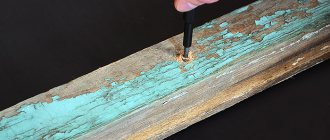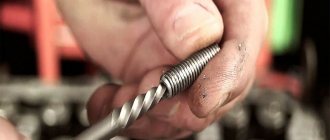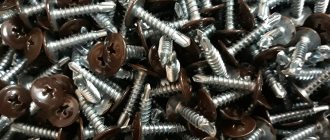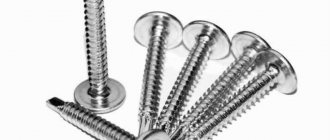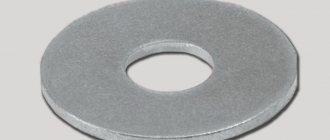Use abrasive powder
As with steel wool, the more grip between the screw head and the screwdriver, the better. You can sprinkle the surface of the screw with a small amount of abrasive scouring powder or fine sand, then apply a screwdriver to the screw and try to remove it. In many cases, powder or sand is enough to keep the bit from slipping off the screw.
Why are the edges of the screw torn off?
There are several negative factors that explain why the head does not unscrew:
- corrosion of the metal, as a result the structure of the material is disrupted, it loses its properties, becomes less durable, crumbles, this leads to the fact that during the repair the technician will not be able to dismantle it by unscrewing the rusty fasteners;
- a screw tends to spin if it has been installed in a structure made of the wrong material.
The problem of how to unscrew a screw arises when the rules for using the tool are violated.
The problem occurs when the rules for using the tool are violated
crosshead screwdriver
Possible causes of fastener damage:
- poor quality of the tool: the metal is too soft, which causes the screwdriver to constantly slip out, the sharp edges have become dull due to wear, this also does not allow the screw to be firmly fixed in the slot, in addition, the tool may be incorrectly selected for such work (does not match the head size);
- weak efforts in the process of unscrewing the fastener, while the screwdriver is not held in the slot, constantly slips, as a result the head is deformed, for this reason it is called “slipped”;
- At the installation stage, the fasteners were installed in a structure made of a material that does not match the screws, because of this it rotates; using a screwdriver it will not be possible to pull out such hardware.
The tool may not be selected correctly for the job.
Screwdriver bit
A common problem with using power tools is the incorrect choice of operating speed. Use moderate force to drill out the fasteners. The operating time of the screwdriver should be short. If you drill a screw intensively, the slot will become deformed. As a result, you will have to additionally decide how to unscrew a screw with a damaged head, which will increase the time it takes to complete the work.
If you drill a screw intensively, the slot will become deformed.
Drill the screw
Select a drill bit that is slightly smaller in diameter than the screw head. Place it in the center of the screw head and drill slowly to create a hole 1 to 3mm deep. Remove the drill from the screwdriver and install the cue ball. Often the hole will help the screwdriver go deep enough into the screw, which will improve the grip between the cue ball and the screw.
Several techniques for removing a screw or self-tapping screw with a torn cross
When choosing a method, the degree of complexity of the task is taken into account. It is necessary to determine how deep the fastener is located in the layer of material. The condition of the surface is assessed: is there any rust, how badly damaged is the screw head. Use auxiliary means: rubber, chisel, hammer. If you plan to use the impact method on the fasteners, you need to prepare a gasket: made of brass, copper. This will avoid the final destruction of the hardware head.
Press down on the screwdriver
The main mistake when unscrewing fasteners is not using enough force. If you ensure a high degree of tight contact between the tool tip and the edges of the slot, you can contribute to the displacement of the screw. However, it is important to know in which direction the product is untwisted.
Hardware is produced with right-hand threads, but less common are screws that are screwed in the other direction - counterclockwise. If you put a lot of effort into unscrewing the fastener, you can screw it even more tightly into the layer of material in this way. When it becomes clear that the product cannot be touched by a screwdriver, you should immediately stop trying to remove it this way.
Press down on the screwdriver while rotating
Regular rubber band and screwdriver
The principle of action of such a tool is similar to how a screwdriver works in the previously discussed case. However, thanks to the rubber seal, the contact area increases. As a result, the chances of fastener removal increase. Instructions:
- It is recommended to use wide rubber, which increases the contact surface area;
- first you need to cover the sharp edge of the screwdriver with an elastic material, it is pulled tightly enough to ensure a tight fit, but there is a risk of deformation of the coating, so you should not be too zealous;
- the tool with the seal is installed in the slot, then they begin to slowly rotate the screwdriver.
The method is suitable for unscrewing a screw that is not too licked, how fasteners are removed - to answer this question, you need to understand the mechanism of action of a screwdriver: it begins to unscrew the fastener when it fits tightly to the edges of the slot, and the rubber partially fills the defects of the head. As a result, the friction between the tool and the hardware increases, which allows the latter to move from its place.
It is recommended to use wide tires
Drill the head
If the fastener protrudes slightly above the surface of the structure, it can be removed using a drill or screwdriver. You don’t have to put a lot of effort into this; the tool will do everything on its own. You only need to open the chuck. The tool is then placed on top of the screw.
When the head is fixed in the chuck, the drill and screwdriver turns on. After a few seconds, the fastening element is removed. The disadvantage of this method is its limited application. In most cases, the head of the hardware is deformed when it is flush with the surface of the structure. It will be impossible to capture her in this case.
Can be removed using a drill or screwdriver
Chisel and hammer
This method will not provide the required result if the fastener is completely recessed. The purpose of using impact tools is to move the screw slightly. This will make the unscrewing process easier. The chisel is installed at an angle relative to the fastener head. The hammer makes 1 blow. You should not repeat these steps many times, as in this case you can destroy the head. This option is suitable for situations where rust has formed on a metal product.
The purpose of using impact tools is to move the screw slightly
Extractor drilling method
This tool for removing threaded fasteners comes in different versions, differing in size. It resembles a drill, but has a conical shape and a thickened base. Before using it, you should prepare the fasteners. A small cross-section hole is made in it. The extractor is selected taking into account the diameter of the recesses of the threaded part of the screw - the tool should be smaller. To unscrew the product, a left-hand thread is cut into the hole. Please note that the screws have right-hand threads.
Drill a hole in the screw head
Screw extractor
Do not hit the extractor too hard
Turn the extractor
When the manipulations are completed, the fastening element is removed. The extractor is used for unscrewing various types of hardware. However, they are not used for self-tapping screws. This is due to the fact that such products are made from hardened steel. In this case, the fastener will move to the side when you try to drill it.
The extractor is used for unscrewing various types of hardware
Fastening element, can be easily removed
Sawing the edge
When the screw head becomes deformed, it is possible to remove such hardware by increasing the size of the slot. However, this increases the risk of fastener failure. As a result, it will be more difficult to remove. To avoid such consequences, it is recommended to make 1 cut - along the center line. Both cross-shaped grooves should not be expanded or increased in length.
Make a cut
To make the cut, it is recommended to use a hacksaw or grinder. The process produces metal shavings. It must be removed periodically to provide visibility for a quality cut. It should not be made more than 2 mm in depth. This will destroy the head. When the groove is ready, use a flathead screwdriver to remove the hardware.
Use a hacksaw for metal
With glue
Various adhesives are used. The purpose of this method is to ensure a high tight fit of the screwdriver. It is glued to the screw head. When the composition is completely dry (this may take 1-2 days), begin to unscrew the fastening element. Recommended types of mixtures: super glue, epoxy glue. The disadvantage of this method is the low degree of reliability. If you apply a little more force than necessary, the connection will break, and you will have to look for a new way to remove the hardware.
Various adhesives are used
Additional method
You can use a welding machine. In this case, the nut is welded to a metal product. The result is a strong connection. It is necessary to unscrew the nut, and the torn fastener will be removed along with it. This method also has limitations in use. Thus, it should not be used if it is necessary to remove a screw from flammable materials. In addition, the contact point is small, which will make the process difficult.
Weld the nut
A strong connection is created
Unscrew the nut
Use elastic bands to grip
Wide rubber bands work well to ensure that the screwdriver has enough grip on the stripped screw. Cut the rubber band with scissors and place it on the head of the screw. Place the screwdriver on the rubber band and press firmly while turning the screw counterclockwise.
Follow us on Pinterest for more interesting articles.
Useful short videos from Make-Self.net
Cardinal way
While it is still possible to unscrew a self-tapping screw with broken edges, if the head breaks or the thread is broken, this becomes very problematic. In such cases, there is often no other choice but to drill out the fasteners with a tubular cutter along with the wood. She cuts the tree around the circumference, making a cylindrical hole in it. The self-tapping screw remains in the removed part, and a plug made in the same way from another piece of wood is subsequently hammered into the hole. After sanding and painting, the defect becomes almost invisible.
Watch a video on how to drill a self-tapping screw from wood:
If the integrity of the surface is not important and you just need to separate the fastened parts, you can do without a milling cutter, using a chisel and a hammer.
Advice! When driving screws into hardwood, plywood or chipboard, it is advisable to treat the threads with lubricant, soap or wax. This will make screwing easier and reduce the risk of breaking off the head or breaking off the notches on the cap.
Source userapi.com
Rusted nut
Another problem that is familiar to car enthusiasts (and not only) is a rusted nut and/or thread. In this case, you should not make heroic efforts to unscrew the fasteners. Your edges will simply “stick together” and another problem will be added to the boiling thread. If after a couple of attempts you can’t unscrew it, try the following methods one by one:
- Tap the bolt with a wrench. There is a chance that the rust will crack and the nut will be unscrewed.
- Fill the connection with kerosene and wait. It will eat away the rust, after which it will be easier to unscrew the rusted nut. But during this operation you cannot smoke, turn on welding, or be near an open flame.
- Warm up the nut. The metal will expand, making it possible to unscrew it. The trick is to get the nut to heat up while the bolt shank stays cold, so heating up must be fast. To do this, use a hair dryer or an open fire (be careful with this). If the screw is small, you can take a powerful soldering iron, heat it to maximum temperature, then quickly heat the joint.
This method will (almost) destroy the nut, so it should only be used in hopeless situations. Grooves are made on the edges (using a metal saw, grinder, or file). A flat screwdriver is pressed into this groove, giving it a direction in the direction of unscrewing. The handle is hit with a hammer. If there is at least a couple of movements, it may be possible to unscrew it.
- Use a special puller (pictured above). Using a bolt, the pin rests on one of the faces, after which you can try to move it from its place. Due to the fact that the lever can be attached, it can work even in very difficult situations.
You can also fight rust with lubricant. Try filling the joint with fluid universal lubricant (available in WD40 cans). After waiting a couple of hours, we try to work with the key. If it doesn’t work, we try other methods one by one.
How to unscrew the soured bolt in the silent block?
Fill with “weedishka” - if the bolt in the bushing is not too completely soured, this method will help to unscrew it. If necessary, you can leave the bolts overnight or for a day to dry. Then they should be warmed up. After this they usually unscrew.
Interesting materials:
When can you pay off your mortgage with maternity capital? When can you water grapes in spring? When can you change the tax regime for individual entrepreneurs? When can we remember the dead? When can you get married? When can you use the cash method? When can honey be pumped out? When can you aerate your lawn? When can dividends be distributed for the year? When can you tell a dream without it coming true?
Detailed consideration of various techniques
Here we will talk about the most effective and common ways to unscrew a bolt if it is spinning or a stuck nut. Among them, you can choose the appropriate ones for each specific situation.
Application of various wrenches
The use of open-end wrenches can be called very popular. However, when using them they encounter the following disadvantages:
- The gap between the key and the nut is not always tight. It often exceeds half a millimeter, affecting the grip density.
- This tool only covers three of the six faces.
Therefore, when using it, it is easy to tear off the nut instead of unscrewing it. Other types of keys may not have such disadvantages. For example, a socket or socket wrench covers all six edges, allowing for a tight grip and increasing the chances of successfully unscrewing a frozen part.
Using a long-handled tool may help. In this situation, having good leverage will allow you to exert more force. The length of the handle can be increased artificially, for example, by using a long pipe. However, in the case considered, it will be less convenient to perform the necessary movements.
Using a gas nag is an effective means of loosening nuts Source moy-instrument.ru
